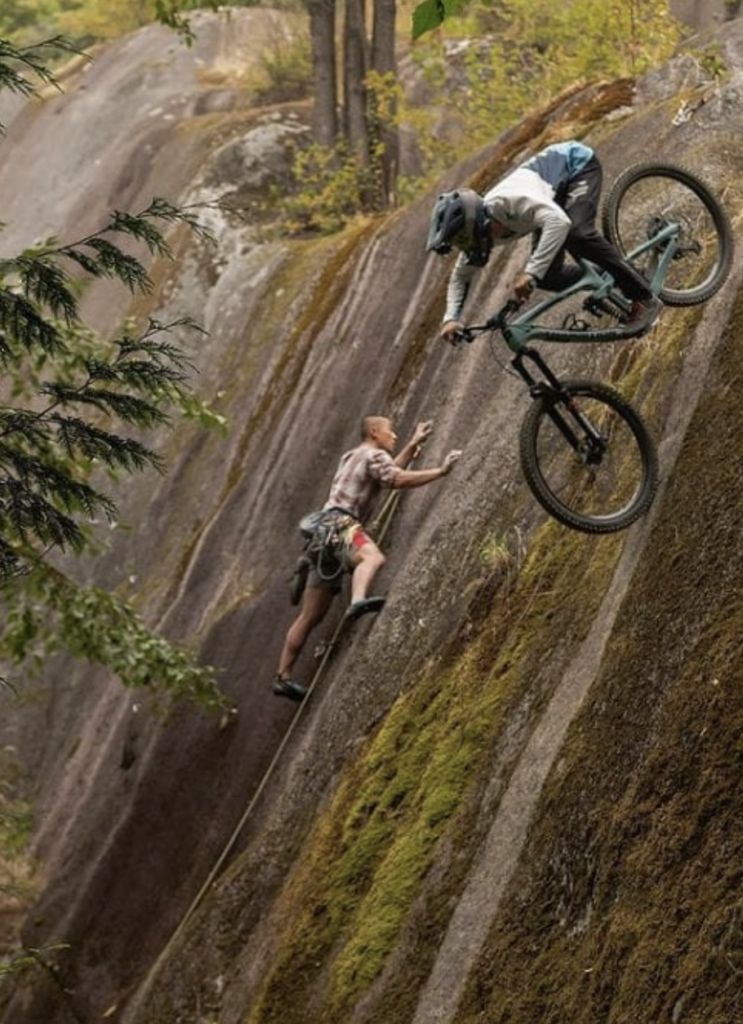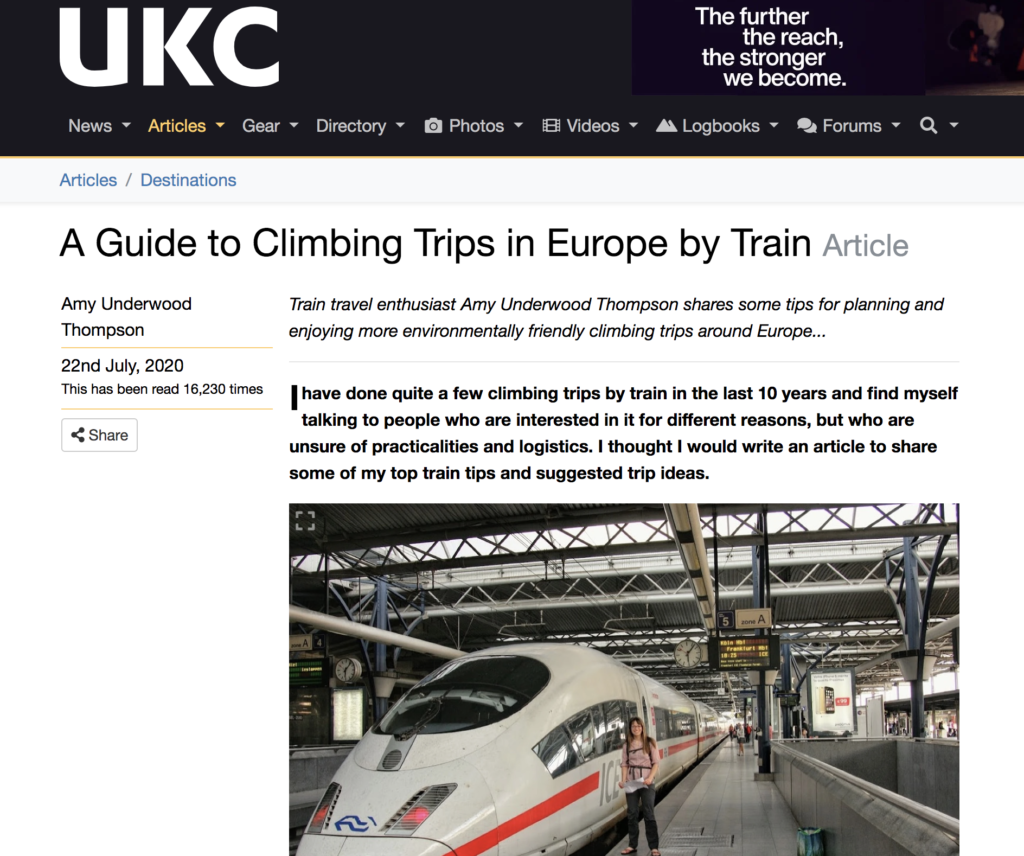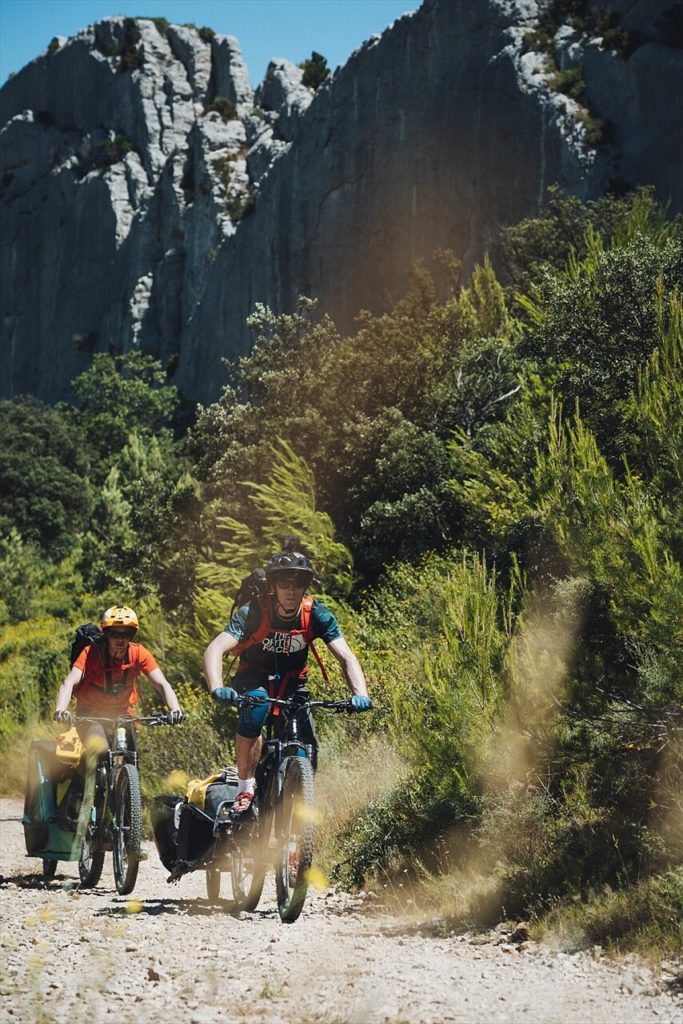Pour les fatalistes, le combat est déjà perdu. Les pessimistes pensent que les actions individuelles, même nombreuses, constituent une goutte d’eau sans avenir. D’autres encore ne s’en préoccupent pas du tout tant qu’ils peuvent s’adonner à leur passion. Seuls les derniers, appelons-les « réalistes » puisqu’ils agissent concrètement, veulent croire que leurs gestes ont du sens. Pas nécessairement pour régler un problème tout bonnement monumental mais, primo, par acquit de conscience personnel, et deuzio pour montrer une voie possible qui change des habitudes héritées d’une époque où on croyait encore que l’âge d’or serait pérenne.
Nous ne voulons surtout pas passer pour des donneurs de leçon, ni nous placer en modèle de quoi que ce soit. Les membres de Fanatic Climbing ne sont pas parfaits, et nos réflexions et actions évoluent avec le temps, chacun tentant à sa manière de se mettre au clair avec ses façons de faire. Tout le monde n’a pas six mois de vacances pour aller au Yosemite en voilier. Par contre il nous semble intéressant — pour pourquoi pas inciter d’autres que nous à voir les choses différemment ? — de montrer que certains grimpeurs et grimpeuses professionnels ou médiatisés ont décidé d’une pratique plus vertueuse et verte, moins comsommatrice. En voici quelques exemples.
ACTS : Action Collective de Transition pour nos Sommets
Ce collectif a été fondé par Arnaud Petit et Christophe Dumarest en 2020. Quelques jours après notre critique des Neom Games l’année dernière, l’ACTS envoyait à l’IFSC une lettre ouverte signée par le who’s who de l’escalade mondiale, dont Adam Ondra, Tommy Caldwell, Margo Hayes, Kylian Jornet ou encore Catherine Destivelle : 110 « célébrités » en tout dénonçaient ainsi l’implication de la fédération internationale d’escalade dans ce projet totalement déplacé.
Comme le dit Arnaud Petit: « Les sportifs ont valeur d’exemple (…). Voir s’engager des pros dont l’activité dépend de la montagne peut motiver des amateurs. (…) Nous sommes beaucoup d’athlètes à avoir non seulement un sentiment de culpabilité face à la situation écologique, la conscience qu’on dégrade notre environnement mais aussi une volonté de le préserver (…). Nous sommes portés par notre dualité, entre une pratique propre et le fait que nous sommes de grands voyageurs. Comment mettre en adéquation nos convictions et nos actes ? »
Pour Christophe Dumarest, « peut-être qu’on peut mettre notre petite notoriété dans le milieu de la montagne au profit des causes environnementales. C’est important de se mettre en route avec des propositions pragmatiques et concrètes. Nous n’avons pas toujours été exemplaires mais il n’est pas trop tard pour se mettre en action. » (extraits d’un entretien paru chez Ecolosport)
Dave MacLeod
Il y a 10 ans, le grimpeur écossais décidait de ne plus prendre l’avion pour des raisons environnementales. Depuis, il trouve projet après projet chez lui, aidant ainsi à développer l’escalade sportive, trad et hivernale de haut niveau dans un pays au potentiel énorme. Quelques mois avant sa décision, MacLeod était parti explorer le mont Stetind, au nord de la Norvège. Grâce à l’argent économisé depuis, le grimpeur s’est offert la voiture électrique qu’il s’était promis, et vient de boucler la boucle en retournant, au volant de son EV, à Stetind. À noter que la mise en valeur de son environnement direct commence à inspirer d’autres britanniques, tels que Robbie Phillips ou Aidan Roberts.
Nolwen Berthier
La tombeuse de « Supercrakinette », 9a+, de longue date engagée dans une réflexion sur la soutenabilité, a cette année mis sur pied le projet « Une voie pour la nature » (itw débrief à venir). Celui-ci « mêle escalade, écologie et art ». Il s’agit pour Nolwen « de réaliser 2 aventures, sous forme de voyages bas-carbone, à deux pas de la maison :
- Fin mai, une expédition en voilier dans les Calanques de Marseille, explorera la Ville et l’Océan
- Fin septembre, un voyage en train autour d’Annot, explorera les Forêts et les Rivières.
Mais plus qu’un trip grimpe, c’est une démarche d’apprentissage en lien avec le Vivant !
Seb Berthe, Soline Kentzel et Hugo Parmentier
Quiconque entreprend de se rendre au Yosemite en voilier puis van pourri possède quelques convictions écologiques. Soline Kentzel et Seb Berthe l’ont fait, sans pour autant s’en satisfaire. Avec son colocataire et compère Hugo Parmentier, lui aussi acquis à la cause environnementale, l’année dernière Seb Berthe s’est lancé le défi de 100 blocs en 7A à la journée à Fontainebleau en déplacement bas carbone (à pied ou à vélo) ou encore le projet VAUTOUR cet été au Verdon, sur lequel on reviendra prochainement.
Dans une interview, Hugo nous donnait des pistes de réflexion : transports, alimentation, logement, banque.

Éline le Menestrel et Katherine Choong
La première est fan d’écopoint depuis plusieurs années, et vient d’embarquer son amie Katherine Choong dans la première ascension féminine de la GV « Zahir », 8b+, dans le style précité. En écopoint, l’ascension dépasse le simple enchainement d’une voie, prenant en compte le voyage bas carbone à partir de chez soi dans la réussite du projet.
L’année dernière déjà, Éline s’était illustrée dans cette pratique avec l’initiative Upossible, résumée en chiffres comme suit:
- 5 spots de grimpe
- 880 km de vélo
- 4515 km de train
- 42 jours à sillonner les routes
- 6 pays traversés (France, Belgique, Autriche, Luxembourg, Allemagne, Italie)

Symon Welfringer
Alpiniste et grimpeur de haut vol, Symon est météorologiste de formation. Ses expéditions l’amènent souvent à l’autre bout du monde, mais dès qu’il le peut il aime se plier à une mobilité douce. En 2023 il réalisait l’ascension de « Recto-verso » (250m/7b) en solo auto-assuré avec approche en vélo depuis Grenoble, aller-retour et en autonomie 220km / 4000m D+.
Dans la même veine, il y a quelques semaines Welfringer a ouvert avec des amis un big wall sur un mont vierge du Groenland, avec approche en kayak. 450km de kayak.
Pablo Recourt
Encore un adepte du vélo : le Belge Pablo Recourt, qui a parcouru la France en pédalant à la recherche du meilleur 8a national dans le cadre de son projet « En quête du saint 8a ». Redonnons ici un extrait de notre entretien avec lui:
« Après mes études, je voulais voyager. J’imaginais acheter un van et partir grimper. Mais avec cette mode du van, il y a quelque chose qui me dérange. Premièrement, ça reste une manière de voyager pas très respectueuse de l’environnement. Bof en accord avec mes valeurs et choix de vie. Et puis en van il y a un peu cette dynamique de “consommation” des falaises. Tu roules, tu arrives à un spot, tu grimpe, tu dors sur le parking, et puis tu t’en vas. Pour moi, ça ne colle pas avec ce que je voulais vivre en voyage. J’ai donc commencé à penser au slow travel, manière de voyager plus lente et proche de ton environnement. »
Tanguy Topin et Romain Noulette
Dans un style proche de Pablo, les deux amis ont voulu mettre en lumière des voies dans le 8a aux alentours de Grenoble, toujours à vélo, et en ont tiré un film : « Bike to eight« .
Sofie Paulus
Sofie, qui a coché 8c, est assistante de recherche en écologie du sport à l’Université de Bayreuth, Allemagne, et a fondé Ecopoint Frankenjura. Dans ses mots, grimper une voie en écopoint « décrit l’idée d’utiliser les transports publics, le vélo ou la marche pour se rendre sur un site d’escalade. C’est souvent un défi et demande plus de temps que des moyens moins verts. À mon avis, cela prolonge l’expérience de l’escalade extérieure et la rend plus intense ainsi que plus enrichissante. »
Retrouvez davantage d’informations sur l’initiative et les guides qu’elle produit ici.

Conclusion
Arrêtons ici notre tout petit tour d’horizon. Son but n’est pas d’exhaustivité, plutôt de mise en bouche. « Show, don’t tell » disent les anglosaxons : montre, ne dis pas. Ce sont les exemples d’une pratique prenant en compte un contexte chamboulé par de multiples facteurs qu’il faut donner, pas des leçons.
Les articles traitant de ces sujets sont pléthores (nous aimons entre autres celui-ci, de Montagnes magazine), pas uniquement en escalade. Les sports de nature, et même certains autres d’ailleurs (revêtements de gymnase plus écologiques, etc), se rendent dans l’ensemble compte que faire l’autruche n’est pas plus une solution aujourd’hui qu’hier.
Tableau de Yoshida Hiroshi : ‘Mt Rainier’, 1925
For the fatalists, the battle is already lost. Pessimists believe that individual actions, however numerous, are but a drop in the ocean. Still others don’t care at all as long as they can indulge their passion. Only the last few – let’s call them ‘realists’ because they take concrete action – want to believe that their acts mean something. Not necessarily to solve a problem that is simply monumental, but firstly, out of a sense of personal responsibility, and secondly, to show a possible way forward that changes the habits inherited from a time when we still believed that the golden age would last forever.
We certainly don’t want to be seen as giving lessons, or setting ourselves up as models for anything. The members of Fanatic Climbing are not perfect, and our thoughts and actions evolve over time, as each of us tries in our own way to come to terms with the way we do things and why. However, we think it would be interesting – and why not encourage others to see things differently – to show that some professional climbers, as well as non-professionals, have adopted more ‘virtuous’, less impactful practices. Here are a few examples.
ACTS: For Our Summits
This collective was founded by Arnaud Petit and Christophe Dumarest in 2020. A few days after our criticism of the Neom Games last year, the ACTS sent the IFSC an open letter signed by the who’s who of world climbing, including Adam Ondra, Tommy Caldwell, Margo Hayes, Kylian Jornet and Catherine Destivelle: 110 ‘celebrities’ in all denounced the involvement of the international climbing federation in this totally inappropriate project.
As Arnaud Petit says: ‘Sportsmen and women set an example (…). Seeing the commitment of professionals whose activity depends on the mountains can motivate amateurs. (…) Many of us athletes have not only a feeling of guilt about the ecological situation, an awareness that we are damaging our environment, but also a desire to preserve it (…). We are driven by our duality, between our own practice and the fact that we are great travellers. How can we reconcile our convictions with our actions?’
For Christophe Dumarest, ‘maybe we can use our little reputation in the mountain world to help environmental causes. It’s important to get started with pragmatic and concrete proposals. We haven’t always been exemplary, but it’s not too late to take action.’ (excerpts from an interview published by Ecolosport)
Dave MacLeod
10 years ago, the Scottish climber decided to stop flying for environmental reasons. Since then, he has found project after project at home, helping to develop high-level sport, trad and winter climbing in a country with enormous potential. A few months before his decision, MacLeod set off to explore Mount Stetind in northern Norway. With the money he has saved since then, the climber bought the electric car he had promised himself, and has now come full circle by returning to Stetind in his EV. It’s worth noting that his commitment to his immediate environment is beginning to inspire other British climbers, such as Robbie Phillips and Aidan Roberts.
Nolwen Berthier
The climber of ‘Supercrakinette’, 9a+, who has long been committed to sustainability, has this year set up the ‘Une voie pour la nature’ project (debrief to follow). This project ‘combines climbing, ecology and art’. For Nolwen, it’s a question of ‘carrying out 2 adventures, in the form of low-carbon journeys, a stone’s throw from home:
- At the end of May, sailing expedition in the Calanques of Marseille, exploring the city and the ocean.
- At the end of September, train journey around Annot, exploring the Forests and Rivers.
But it’s more than just a climbing trip, it’s a way of learning about the Living!
Seb Berthe, Soline Kentzel and Hugo Parmentier
Anyone who sets out to travel to Yosemite on a sailing boat and then a rotten van has a few ecological convictions. Soline Kentzel and Seb Berthe have done it, but that is far from all. Last year, Seb paired with his flatmate and fellow environmentalist Hugo Parmentier to face the challenge of climbing 100 7A boulders in a day in Fontainebleau, using low-carbon means of transport (on foot or by bike), as well as the VAUTOUR project this summer in Le Verdon, which we’ll be coming back to shortly.
In an interview, Hugo gave us some food for thought on issues ranging from transport, food, housing to banking.
Éline le Menestrel and Katherine Choong
The first has been a fan of ecopoint for several years, and has just taken her friend Katherine Choong on the first women’s ascent of the 8b+ mulitpitch route ‘Zahir’ in the aforementioned style. In ecopoint, the climb goes beyond the simple linking of a route, taking into account the low-carbon journey from home in the overall success of the project.
Last year, Éline had already distinguished herself in this way with the Upossible initiative, summed up in the following figures:
- 5 climbing spots
- 880 km of cycling
- 4515 km by train
- 42 days on the road
- 6 countries crossed (France, Belgium, Austria, Luxembourg, Germany, Italy)
Symon Welfringer
A high-flying mountaineer and climber, Symon trained as a meteorologist. His expeditions often take him to the other side of the world, but as soon as he can he likes to take it ‘easy’. In 2023, he climbed ‘Recto-verso’ (250m/7b) lead rope solo style, getting there and back by bike from Grenoble, autonomously, 220km, 4000m D+.

In the same vein, a few weeks ago Welfringer opened a big wall with friends on a virgin Greenland mountain, with an approach by kayak. 450km of the stuff.
Pablo Recourt
Another cycling enthusiast: Belgian Pablo Recourt, who pedalled his way across France in search of the best national 8a as part of his project ‘En quête du saint 8a’. Here is an extract from our interview with him:
‘After my studies, I wanted to travel. I thought I’d buy a van and go climbing. But there’s something about the van craze that bothers me. Firstly, it’s not a very environmentally-friendly way of travelling. Not really in keeping with my values and lifestyle choices. And then with a van, there’s the dynamic of ‘consuming’ the cliffs. You drive, you arrive at a spot, you climb, you sleep in the car park, and then you leave. For me, it didn’t fit in with what I wanted to experience on a trip. So I started thinking about slow travel, a slower way of travelling that’s closer to your environment.’
Tanguy Topin and Romain Noulette
In a style similar to Pablo’s, the two friends wanted to shine a light on the 8a routes around Grenoble, always by bike, and have made a film about them: ‘Bike to eight’.
Sofie Paulus
Sofie, who has redpointed 8c, is a research assistant in sports ecology at the University of Bayreuth, Germany, and founded Ecopoint Frankenjura. In her words, climbing an ecopoint route ‘describes the idea of using public transport, cycling or walking to get to a climbing site. It’s often a challenge and requires more time than less green means. In my opinion, it extends the outdoor climbing experience and makes it more intense as well as more rewarding.’
Find out more about the initiative and the guides it produces here.
Conclusion
Let’s end our little overview here. Its purpose is not to be exhaustive, but rather to whet the appetite. ‘Show, don’t tell’: as per the saying, it is examples of a practice that takes into account a context turned upside down by multiple factors that need to be given, not lessons.
There are plenty of articles on these subjects (we like this one from Montagnes magazine, among others), and not just in climbing. Nature sports, and even some others for that matter (greener gym floors, for instance), are generally realising that burying one’s head in the sand is no more of a solution today than it was yesterday.
Painting by Yoshida Hiroshi: ‘Mt Rainier’, 1925



